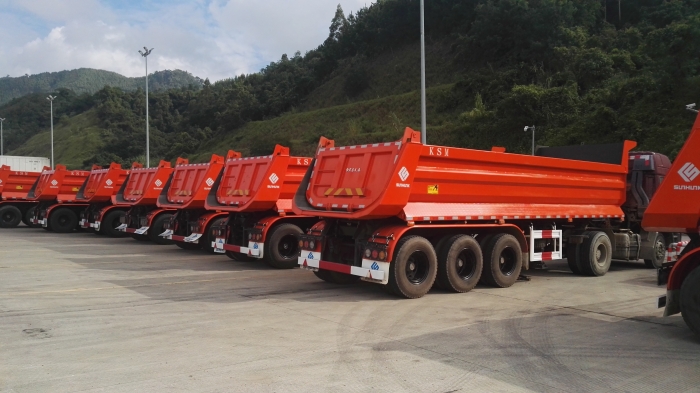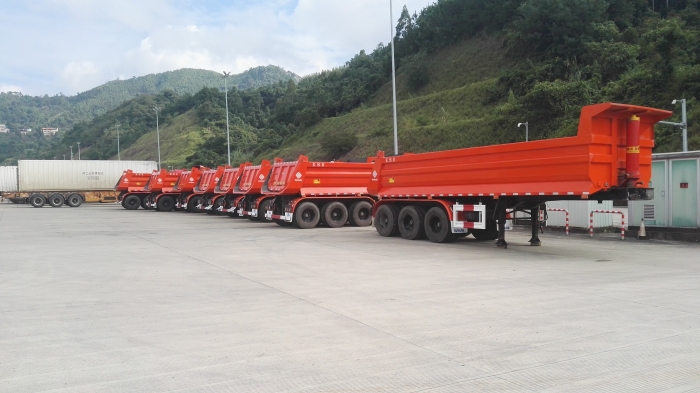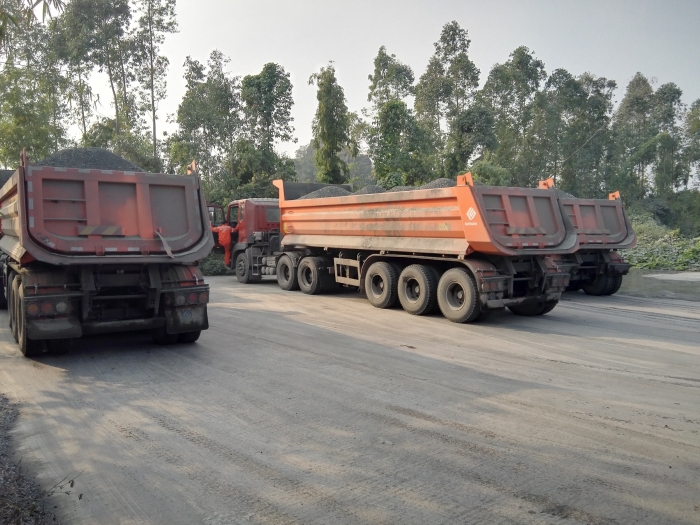- PRODUCTS
- SOLUTION
- SERVICE
- NEWS
- ABOUT US
Dry van semi-trailers are widely used in retail, FMCG, manufacturing, electronics, construction materials, automotive parts, textiles, and agriculture industries for efficient goods transportation.
The retail and distribution industry heavily relies on efficient logistics and transportation solutions to meet the ever-growing market demands. Dry van semi-trailers play a pivotal role in this process, offering a versatile and secure mode of transporting a wide range of goods across vast distances. Optimizing logistics through the strategic use of these trailers not only streamlines supply chains but also significantly reduces operational costs and improves delivery timelines.
Dry van semi-trailers offer substantial benefits for the retail and distribution sectors, primarily due to their ability to protect goods from external elements and their flexibility in handling various types of cargo. The enclosed structure of dry vans ensures that goods, ranging from non-perishable food items to electronics and textiles, remain secure and undamaged during transit. Additionally, the standardization of trailer sizes—commonly 53 feet in length—facilitates easy loading, unloading, and warehouse storage, making them an indispensable asset in logistics.

To adequately meet market demands, companies leverage advanced logistics strategies involving dry van semi-trailers. Real-time tracking technology and efficient route planning are essential components of this logistics optimization, ensuring timely delivery of goods to retailers and distribution centers. For instance, adopting a just-in-time (JIT) inventory approach reduces warehouse storage needs and associated costs, as goods are transported and received as required.
The impact of dry van semi-trailers on the retail and distribution industry is profound, with significant numbers illustrating their effectiveness:
· Fuel Efficiency Improvements: Modern aerodynamic designs of dry vans have led to an average fuel saving of up to 10%, significantly reducing transportation costs.
· Increased Cargo Capacity: With the ability to safely carry up to 45,000 pounds of cargo, dry vans optimize the volume of goods transported per trip.
· Reduction in Delivery Times: Strategic logistics planning can result in a 20-30% reduction in delivery times, directly benefiting retail operations and customer satisfaction.
Successfully integrating dry van semi-trailers into the logistics strategy involves several key steps. Firstly, adopting advanced logistics software enables precise tracking and management of shipments, enhancing the overall efficiency of the supply chain. Secondly, regular maintenance schedules ensure that the trailers remain in optimal condition, reducing the risk of delays due to mechanical failures. Lastly, training for drivers and logistics personnel on the best practices in loading, unloading, and transporting goods maximizes the safe and efficient use of these trailers.
The Fast-Moving Consumer Goods (FMCG) industry thrives on the ability to efficiently transport products while maintaining their quality and freshness. This sector, characterized by high volume and low margin products, demands rigorous transportation and protection measures to ensure goods reach consumers in optimal condition.
Maintaining Freshness: For perishable goods, such as food and beverages, the transportation process must prioritize maintaining freshness. This often involves the use of refrigerated or climate-controlled dry van semi-trailers, which can keep products within a specific temperature range. For example, refrigerated trailers are capable of maintaining temperatures from -20°F to 70°F, ensuring that a wide range of products can be transported safely.
Protection Measures: Beyond temperature control, protecting the integrity of packaging and preventing contamination are paramount. Implementing robust packaging standards and utilizing trailers with clean, secure environments are essential steps. Additionally, the strategic use of palletization and shrink-wrapping can significantly reduce the risk of damage during transit.
The manufacturing industry relies heavily on a seamless flow of raw materials to production sites and the efficient distribution of finished products. The logistical backbone of this industry is the transportation network, which must be both reliable and flexible.
Raw Material Delivery: Timely and consistent delivery of raw materials is crucial to avoid production delays. Manufacturers often use just-in-time (JIT) logistics strategies to minimize storage costs and reduce inventory levels. This approach requires precise coordination with suppliers and transporters to ensure materials arrive exactly when needed.
Finished Goods Distribution: Once products are manufactured, efficiently distributing them to wholesalers, retailers, or directly to consumers is the next challenge. Here, the use of dry van semi-trailers is widespread due to their versatility in handling various types of goods. For heavy or oversized items, specialized trailers such as flatbeds may be necessary.

Transporting electronics and home appliances presents unique challenges due to the sensitive and high-value nature of these products. Ensuring their safety and integrity during transit requires specialized handling and transportation strategies.
Shock and Vibration Protection: Electronic products are susceptible to damage from shock and vibration. Utilizing packaging materials that absorb impact and reduce vibration is essential. Furthermore, trailers equipped with air-ride suspension systems offer an additional layer of protection by smoothing out the ride during transportation.
Electrostatic Discharge (ESD) Prevention: To prevent damage from electrostatic discharge, electronic components and devices must be packed in ESD-safe materials. These include antistatic bags, bubble wrap, and foam, which help to safely dissipate static electricity away from sensitive components.
For all three industries, implementing effective logistics solutions involves a combination of advanced planning, technology integration, and strategic partnerships. Real-time tracking systems, for example, provide visibility throughout the transportation process, allowing for timely adjustments and enhanced security. Moreover, establishing strong relationships with reliable transportation partners ensures that logistical operations can scale with demand, maintaining efficiency and product quality.
In conclusion, the transportation needs of the FMCG, manufacturing, and electronics and appliances industries are diverse and complex. Each sector requires tailored logistics strategies that prioritize freshness, protection, and the special handling of products. Through careful planning, technology adoption, and partnership development, companies can overcome these challenges, ensuring their products arrive in excellent condition, ready for the end consumer.
The construction and building materials industry faces unique logistics challenges due to the size, weight, and variety of materials required on construction sites. Transporting large and heavy building materials, such as steel beams, concrete blocks, and large machinery, requires specialized logistics solutions to ensure safety, efficiency, and cost-effectiveness.
Size and Weight Constraints: The primary challenge in transporting construction materials is their size and weight. Standard trailers may not suffice for oversized loads, necessitating the use of specialized equipment such as flatbed trailers and heavy haulers. These materials often require special permits for transportation, adding complexity to logistics planning.
Safety and Damage Prevention: Ensuring the safety of both the transport team and the materials during transit is crucial. Heavy materials pose significant risks if not secured properly. Furthermore, sensitive materials like glass and precision equipment demand additional protection to prevent damage.
Utilizing Specialized Transportation Equipment: Employing flatbed trailers, extendable trailers, and heavy haulers equipped with features like air-ride suspension ensures safe and efficient transport of heavy and oversized items. For example, extendable trailers can carry loads up to 80 feet long, accommodating even the most cumbersome materials.
Implementing Rigorous Safety Protocols: Strengthening tie-down procedures and using protective coverings are essential for preventing material damage and ensuring road safety. Regular training sessions for drivers and logistics personnel on handling and securing diverse materials further enhance safety measures.
Transporting automotive parts presents its set of challenges, primarily due to the need for timeliness and the high value and sensitivity of parts. The automotive supply chain operates on a just-in-time (JIT) basis, requiring precise coordination and flawless execution to prevent costly production line stoppages.
Timeliness and Reliability: Automotive production lines depend heavily on the timely delivery of parts to maintain efficiency and reduce inventory costs. Delays in delivering critical components can halt production, leading to significant financial losses.
Handling and Security: Auto parts range from small, sensitive electronic components to large body panels. Each type requires specific handling procedures and security measures to prevent damage and theft, especially for high-value items like airbags and infotainment systems.

Advanced Tracking and Scheduling Systems: Implementing real-time tracking and scheduling systems allows for precise monitoring of shipments and better coordination with manufacturing schedules, minimizing the risk of delays.
Specialized Packaging and Handling: Customized packaging solutions and handling protocols ensure the protection of sensitive components during transit. Reinforced packaging for delicate items and secure strapping for larger parts are examples of such measures.
The textile and apparel industry requires meticulous handling and transportation strategies to maintain product quality, prevent damage, and ensure items arrive ready for retail presentation.
Climate Control: Maintaining a controlled environment within transportation units is vital for preventing damage from humidity and temperature fluctuations, which can affect fabric quality and garment appearance.
Protective Packaging: Employing protective packaging materials and methods, such as garment-on-hanger (GOH) systems, minimizes creasing and damage, ensuring clothing arrives in retail-ready condition.
Transporting agricultural machinery and dry agricultural products involves navigating size, weight, and environmental challenges to ensure timely delivery and maintain product quality.
Agricultural Machinery: The size and weight of agricultural machinery require the use of specialized trailers, such as low-loaders or flatbeds, for safe transportation. These items often exceed standard dimensions and weights, necessitating permits and escort vehicles for road transport.
Dry Agricultural Products: Grains and other dry products must remain dry and free from contamination during transport. Using covered hopper trailers or dry vans with proper sealing and ventilation ensures these products arrive in optimal condition.
Strategic Route Planning: Careful planning of routes and schedules minimizes transit times and ensures compliance with regulatory requirements for oversized and overweight loads.
Quality Control Measures: Employing tarps and moisture control systems in trailers protects against environmental damage, while regular cleaning protocols maintain a contamination-free environment for dry goods.
In conclusion, each industry faces distinct transportation challenges, requiring tailored logistics strategies to ensure efficient, safe, and quality-compliant delivery of goods. Through the implementation of specialized equipment, safety protocols, and advanced technology, companies can overcome these challenges, ensuring their products arrive in the best possible condition.